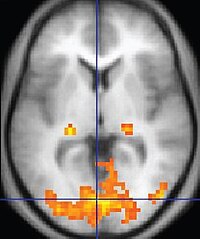
Photo from wikipedia
BACKGROUND The relation between cardiac motion artefact (CMA) in optical coherence tomography (OCT) and the phases of cardiac cycle is unclear. METHODS Optical coherence tomography pullbacks containing metallic stents were… Click to show full abstract
BACKGROUND The relation between cardiac motion artefact (CMA) in optical coherence tomography (OCT) and the phases of cardiac cycle is unclear. METHODS Optical coherence tomography pullbacks containing metallic stents were co-registered with angiography and retrospectively analyzed. The beginning of three phases, namely ejection, rapid-inflow and diastasis, was identified in angiography. Rotation, shortening, elongation and repetition were qualitatively labelled as CMA artefacts. Platforms with coaxial longitudinal connectors (ML8 and Magmaris) entered a quantitative sub-study, consisting of measuring the length of their connector at the beginning of each phase. RESULTS A total of 261 stents (127 patients) were analyzed, including 105 stents for quantitative sus-tudy. CMA was detected in 61 (23.4%) stents: rotation in 6 (2.3%), shortening in 50 (19.2%), elongation in 51 (19.5%) and repetition in 12 (4.6%). Shortening was always observed during ejection phase, while elongation and repetition were always observed during rapid-inflow. Rotation occurred in both ejection and rapid-inflow phases, while no artefact was reported during diastasis. Longitudinal connectors measured in early ejection phase and in early rapid-inflow phase were shorter and longer, respectively, than those measured in diastasis, irrespective of the presence of CMA in the qualitative assessment. CONCLUSIONS Cardiac motion artefact is prevalent in OCT studies, but shortening and elongation of vascular structures occur during early ejection and during early rapid-inflow, respectively, to a greater or lesser extent in all cases. Diastasis is free of CMA and hence the period in which longitudinal measurements can be more accurately quantified.
Journal Title: Cardiology journal
Year Published: 2021
Link to full text (if available)
Share on Social Media: Sign Up to like & get
recommendations!